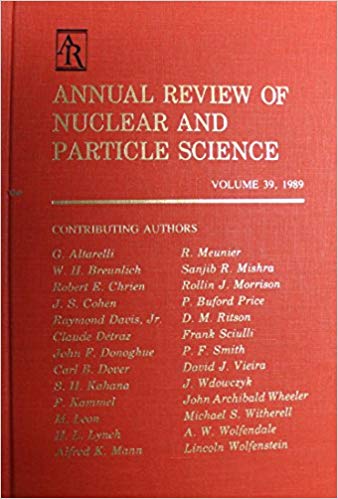Detectors for Relativistic Nuclear Collisions
IF 8.4
2区 物理与天体物理
Q1 PHYSICS, NUCLEAR
Annual Review of Nuclear and Particle Science
Pub Date : 2025-09-22
DOI:10.1146/annurev-nucl-102422-045821
引用次数: 0
Abstract
Detectors for relativistic nuclear interactions have significantly increased in size and sophistication over the last few decades, primarily owing to rising collision energies and rates. Common across most particle physics experiments is the need to measure collision vertex, particle momentum, and particle energy. To accurately measure momenta at the very low level of 100 MeV/相对论性核碰撞探测器
在过去的几十年里,用于相对论性核相互作用的探测器在尺寸和复杂程度上都有了显著的增加,这主要是由于碰撞能量和速率的上升。大多数粒子物理实验都需要测量碰撞顶点、粒子动量和粒子能量。为了精确测量100 MeV/c的极低水平的动量,需要材料预算非常低的跟踪探测器。此外,粒子识别需要使用飞行时间、能量损失和切伦科夫辐射测量的探测器系统。与高亮度质子-质子实验相比,这些探测器面临的辐射水平要低得多,从而可以使用更广泛的传感器技术,并导致该领域的创新发展。近几十年来,数据传输和处理技术的进步使连续数据读出和在线处理成为可能,消除了选择性触发的需要,这大大提高了探测器的性能。本文概述了当前和未来的相对论性核碰撞探测器,并讨论了在这方面的关键技术进展。考虑到未来e + e−希格斯工厂的探测器需求的相似性,这里得出的结论也与该领域的发展有关。
本文章由计算机程序翻译,如有差异,请以英文原文为准。
求助全文
约1分钟内获得全文
求助全文
来源期刊
CiteScore
21.50
自引率
0.80%
发文量
18
期刊介绍:
The Annual Review of Nuclear and Particle Science is a publication that has been available since 1952. It focuses on various aspects of nuclear and particle science, including both theoretical and experimental developments. The journal covers topics such as nuclear structure, heavy ion interactions, oscillations observed in solar and atmospheric neutrinos, the physics of heavy quarks, the impact of particle and nuclear physics on astroparticle physics, and recent advancements in accelerator design and instrumentation.
One significant recent change in the journal is the conversion of its current volume from gated to open access. This conversion was made possible through Annual Reviews' Subscribe to Open program. As a result, all articles published in the current volume are now freely available to the public under a CC BY license. This change allows for greater accessibility and dissemination of research in the field of nuclear and particle science.

 求助内容:
求助内容: 应助结果提醒方式:
应助结果提醒方式:


